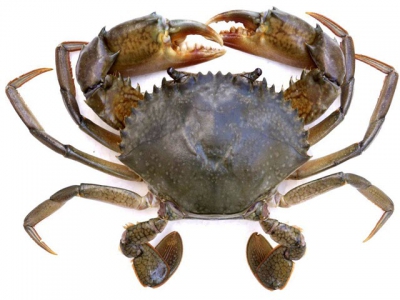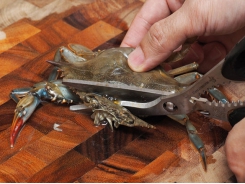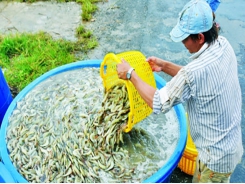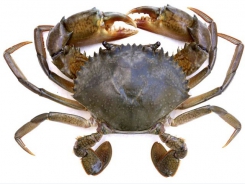Mud crab aquaculture

The mud crab (Scylla serrata) is a promising aquaculture species due to its fast growth and good market acceptability and price. However, a mud crab aquaculture operation requires significant capital input for both the breeding and growout phases.
Mud crab farming requires expertise in husbandry of crustaceans, water quality control, pond management, nutrition, processing and marketing.
Mud crabs have good export potential. The development of new mud crab products, both for domestic and overseas markets, also creates opportunities for farmers. One of these new products is soft-shell crab (i.e. crabs that are harvested when they have just completed moulting). Commercial production of soft-shell crabs has already commenced for blue swimmer crabs (Portunus pelagicus) where the crabs are farmed in a similar manner to mud crabs prior to being harvested for soft-shell production. The processing technologies used for this crab species also apply to mud crab soft-shell production.
Breeding mud crabs
This guide provides an overview of mud crab aquaculture in Queensland, female crabs are protected under the Fisheries Act 1994. If you want to develop an aquaculture enterprise in Queensland you must apply for an aquaculture development approval.
Hatchery phase
Mature female mud crabs kept in large tanks or in ponds under suitable conditions will extrude eggs. Each egg batch contains about 2-5 million eggs and a female may extrude more than one batch in her life. The eggs take 12-14 days to hatch, depending on temperature.
After they hatch, the larvae feed on small planktonic animals. Rotifers or brine shrimp (Artemiaspp.) are live food types used successfully in cultures. Hygiene during the egg and larval phase is critical to success through to post-larvae in the hatchery. Water quality parameters, such as temperature, salinity, pH, oxygen and ammonia, should be maintained at approximately open sea conditions throughout this phase. Crowding of larvae near the end of the cycle can lead to heavy losses due to cannibalism. The fully planktonic zoea larvae grow through 5 stages over 2-3 weeks at 27-28°C before changing into a megalopa.
The megalopa has claws, resembling a small crab with a tail, but still swims actively, voraciously feeding on Artemia juveniles, other larvae and fresh and artificial diets. The megalopa stage lasts about a week before metamorphosing into the first crab stage, which is about 4mm wide.
Nursery phase
Hatchery-produced megalopa or first-stage crabs are typically reared in nursery systems to a more advanced crablet stage, 10-40mm across, before seeding into a growout system.
During the 3-6 week nursery period, the crabs are benthic and cannibalistic but can be successfully reared in shallow nets, tanks or ponds at densities greater than 50 per square metre.
The crabs are fed a diet of artificial formulated feeds, but will readily consume minced fresh diets such as mussel or fish meat. Water quality is less critical at the crablet stages compared with the hatchery phase.
Growing mud crabs
Growout of juvenile mud crabs is a common practice overseas but in Australia it has not yet progressed beyond pilot-scale operations. In aquaculture farms, post-nursery crabs reach marketable size and maturity in 6-7 months compared with 18-24 months under natural conditions.
Farm design
Mud crab growout requires a substantial area of earthen ponds with access to quantities of brackish water. Farm design requirements for mud crabs are very similar to that for marine prawn production. Advances in high-density recirculating production systems may in the future remove some of the constraints on site area required and site availability, but this method of production will be capital-intensive.
Growout is currently being undertaken to a limited extent on prawn farms, which require only minor adaptation of facilities to accommodate the crabs. This is being explored as an enterprise option for remote northern communities.
Stocking rates
During growout in ponds, crab growth and survival are linked strongly to stocking rate. High stock losses due to cannibalism occur when crabs are grown to market size at greater than 3 per square metre. A stocking rate of around 0.5-1.5 per square metre may give the highest productivity and economic benefit in simple earthen ponds.
Mud crabs can be grown in highly intensive systems where they are held separately, resulting in far less loss of stock as there is no cannibalism. This is new technology and commercial production in these cellular systems is yet to be established.
Water quality and temperature
Juvenile and adult crabs are far more tolerant of temperature and salinity change than the larvae. Nevertheless, temperature should be kept below 32oC to avoid water quality problems and above 20°C as growth is greatly reduced at temperatures below this level.
Salinity does not appear to be important to survival provided it stays above 10 parts per thousand (ppt) and does not exceed 45ppt. The ideal salinity range for growth is about 15-25ppt.
Feeding
In the natural environment, mud crabs eat mainly shellfish and crustaceans. This is difficult to achieve in aquaculture conditions, so alternatives are used. Overseas it is common practice to feed trash fish or fish waste or other waste streams; however, this can be inadequate for maximum growth. Feeding with raw animal material is also prone to problems, with water quality deterioration due to fouling.
For this reason, most aquaculture operations should predominantly use formulated dried pelleted rations. Diet development work is underway to find a cost-effective formulation specifically for mud crabs. Good results have been achieved using pellets designed for marine prawn aquaculture.
Shelter
Crabs grow by moulting. They shed their exoskeleton and expand the new, soft shell by inflating it with water and then harden the new larger shell. During moulting, the crab is vulnerable to attack by hard-shelled crabs. This moult-related cannibalism is an important limitation on the density at which crabs can be grown in ponds.
Providing shelter for vulnerable crabs reduces the risk of attack and cannibalism during the short time their shells are hardening. Onion bags or shadecloth, masonry blocks, short lengths of pipe or car tyres can be used to provide shelter. Providing shelter in the pond improves survival and productivity; however, it also complicates pond management. The amount of shelter in the pond is controlled by practical limitations on the maintenance of pond quality, labour and harvesting.
The maximum economic density at which crabs can be grown also depends on the crab size at harvest. The smaller the size, the greater number produced. Segregation of crabs with regard to size and sex may also be beneficial in reducing cannibalism.
Related news
Tools

Phối trộn thức ăn chăn nuôi

Pha dung dịch thủy canh

Định mức cho tôm ăn

Phối trộn phân bón NPK

Xác định tỷ lệ tôm sống

Chuyển đổi đơn vị phân bón

Xác định công suất sục khí

Chuyển đổi đơn vị tôm

Tính diện tích nhà kính

Tính thể tích ao




 US issues lower duty on Vietnamese frozen fish…
US issues lower duty on Vietnamese frozen fish…  Mud Crab Farming
Mud Crab Farming